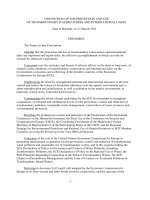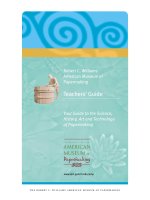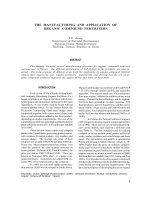the chemistry and technology of gypsum asymposium astm special technical publication stp
Bạn đang xem bản rút gọn của tài liệu. Xem và tải ngay bản đầy đủ của tài liệu tại đây (11.1 MB, 190 trang )
THE CHEMISTRY AND
TECHNOLOGY OF
GYPSUM
A symposium sponsored by
ASTM Committee C-11 on
Gypsum and Related Building
Materials and Systems
Atlanta, GA, 14-15 April 1983
ASTM SPECIAL TECHNICAL PUBLICATION 861
Richard A. Kuntze, Ontario Research
Foundation, editor
ASTM Publication Code Number (PCN)
04-861000-07
1916 Race Street, Philadelphia, PA 19103
This One
Q>
TJLL-8J0-NL7S
rial
Library of Congress Cataloging in Publication Data
The Chemistry and technology of gypsum.
(ASTM special technical publication; 861)
'•ASTM publication code number (PCN) 04-861000-07."
Includes bibliographies and index.
1.
Gypsum—Congresses. I. Kuntze. Richard A.
II.
ASTM Committee C-11 on Gypsum and Related Building
Materials and Systems. III. Series.
TA455.G9C48 1984 666'.92 84-70880
ISBN 0-8031-0219-4
Copyright
° by AMERICAN SOCIETY FOR TESTING AND MATERIALS 1984
Library of Congress Catalog Card Number: 84-70880
NOTE
The Society is not responsible, as a body,
for the statements and opinions
advanced in this publication.
Primed in Ann Artxx. Ml
Scpttmker I9S4
Copyrighted material
Foreword
The symposium on The Chemistry and Technology of Gypsum and Gypsum
Products was presented at Atlanta, GA, 14-15 April 1983. The symposium was
sponsored by ASTM Committee C-11 on Gypsum and Related Building Materials
and Systems. Richard A. Kuntze. Ontario Research Foundation, presided as
chairman of the symposium and is editor of the publication.
Copyrighted material
Related
ASTM Publications
Masonry: Materials, Properties, and Performance, STP 778 (1982). 04-778000-
07
Extending Aggregate Resources, STP 774 (1982), 04-774000-08
Cement Standards—Evolution and Trends, STP 663 (1979), 04-663000-07
Significance of
Tests
and Properties of
Concrete
and Concrete-Making Materials,
STP 169B (1978), 04-169020-07
Copyrighted material
A Note of Appreciation
to Reviewers
The quality of the papers that appear in this publication reflects not only the
obvious efforts of the authors but also the unheralded, though essential, work
of the reviewers. On behalf of ASTM we acknowledge with appreciation their
dedication to high professional standards and their sacrifice of time and effort.
ASTM Committee on Publications
Copyrighted material
ASTM Editorial Staff
Janet R. Schroeder
Kathleen A. Greene
Rosemary Horstman
Helen M. Hoersch
Helen P. Many
Allan S. Kleinberg
Susan L. Gebremedhin
Copyrighted material
Contents
Introduction
Physical Testing of Gypsum Board Per ASTM C
473—
ROBKRT
F ACKKR
Gypsum Analysis with the Polarizing Microscope—
OFOROF W. f.RF.FN 22
The Effect of Sorhed Water on the Determination of Phase
Composition of CaSQ
4
• H;Q Systems by Various
Methods—DANICA
H.
TIIRK
AND
I.ARBI BOUNINI
48
A Simple Apparatus for Measurement of the Hydration Ratio of
Plasters and Plaster
Rocks—ETIESNK
KARMA/SIN
52
Determination of Sulfur Trioxide in Gypsum—s,
GOSWAMI
AND
1),
CHANDRA
62
Rapid Multielement Analysis of Gypsum and Gypsum Products by
X-Ray Fluorescence
Spectroscopy—VLADIMIR
KIX MAN
72
The Relationship Between Water Demand and Particle Size
Distribution of Stucco—I
VDIA
M mrKFVirH
AMI
RICHARD
A. KinrrzE
Retardation of Gypsum Plasters with Citric Acid: Mechanism and
Properties—THOMAS
KOSLOWSKI
AND UDO
LUDWIG
Byproduct
Gypsum—JEAN
W.
PRESSLER
84
97
105
Assessment of Environmental Impacts Associated with
Phosphogypsum in
Florida—ALEXANDER MAY AND
JOHN
W.
SWEENEY
U6
Copyri
Evaluation
of
Radium and Toxic Element Leaching Characteristics
of Florida Phosphogypsum
Stockpiles—AU-XANDER MAY
AND JOHN W. SWI-KNI-V 140
Drying
and
Agglomeration
of
Flue
Gas
Gypsum—KRANZ
wiRSCHINfi
UM)
Summary
173
Index
LZ7
Copyrighted material
Introduction
Recent advances in gypsum chemistry, analytical techniques, and manufac-
turing technologies have raised a number of issues of concern to producers and
users of gypsum products alike. For example, the analysis of gypsum and gypsum
products as covered by ASTM standards is based almost entirely on wet chemical
methods. However, modern instrumental methods are now used routinely in
most laboratories and institutions. They are capable of determining constituents
and impurities of gypsum and its dehydration products more accurately and
reliably than conventional methods.
In addition, by-product gypsums are increasingly considered as raw material
in the manufacture of gypsum products as partial or complete replacement of
natural gypsum. Present ASTM standards do not deal with these synthetic ma-
terials, which provide a number of analytical problems because of the presence
of unusual impurities not normally found in natural gypsums. For the same
reason, the manufacture and application of building materials containing by-
product gypsums is affected by serious difficulties.
In order to address these questions and problems, this symposium was spon-
sored by ASTM Committee C-l
1
on Gypsum and Related Building Materials
and Systems. The symposium was intended to provide a forum for discussions
of theories, test methods and analyses, and basic information on gypsum and
its products.
Richard A. Kuntze
Ontario Research Foundation, Sheridan Park.
Missis&auga. Ontario. Canada. L5KIB3. ed-
Copyrighted material
Copyrighted material
Robert F. Acker*
Physical Testing of Gypsum Board Per
ASTM C 473
REFERENCE: Acker. R. F., "Physical Testing of Gypsum Board Per ASTM C 473,"
The Chemistry and Technology of Gypsum, ASTM STP
Hf>l.
R. A. Kuntze. Ed American
Society for Testing and Materials. 1984. pp. 3-21.
ABSTRACT: This work was performed to investigate modernization of the equipment
used for the physical testing of gypsum board that has not been basically changed over a
period of many years and is not commercially available. A comprehensive study has been
made using a commercially available machine for three strength tests, with the expectation
that this type of equipment might be incorporated into ASTM methods and specifications
in the future. Technical advances in the methods of evaluating gypsum board are desirable
in a progressive industry.
The procedure used was to run the three major physical tests: flexural strength: core,
end. and edge hardness: and nail pull resistance on a machine using constant strain rate
loading and compare those results with those obtained on the commonly used ASTM
specified machine that uses a constant stress rate. A TM 51008 tester made by Testing
Machines. Inc. was used for the work reported in this paper. Comparative tests were made
on equipment conforming to the specifications of ASTM Physical Testing of Gypsum
Board Products. Gypsum Lath. Gypsum Partition Tile or Block, and Precast Reinforced
Gypsum Slabs (C 473). Preliminary work was done in a research laboratory to develop
the fixtures and procedures necessary to use the new equipment. The machine was then
placed in a manufacturing plant and duplicate tests on all types of board products were
run for a period of several months.
Data will be presented to show that the constant strain rate method of testing can give
equally precise results with a very substantial saving in lime and physical effort. For
flexural strength, nail pull resistance, and core hardness there is a simple linear correlation
between the results with the two machines. The constant strain rate machine can more
accurately determine the maximum load causing failure than (he constant stress rate ma-
chine. Correlation between the results of tests on either machine shows that the core
hardness and nail pull resistance tests tend to duplicate information on core properties
KEY WORDS: gypsum, physical tests, physical properties, gypsum board, constant stress,
constant strain
About 1975 the ASTM specifications for gypsum board were changed to
eliminate arbitrary weight limits and substitute performance tests. The tests added
were humidified sag resistance; core, end, and edge hardness; and nail pull
'Research associate. United States Gypsum Company. Graham J. Morgan Research Center. 700
North Highway 45, Libertyvilie, IL 60048.
3
Copyrighted material
4 CHEMISTRY AND TECHNOLOGY OF GYPSUM
resistance. The flexure test that was already in the specifications was retained
as a performance test.
With the exception of sag resistance, these tests are run by using a testing
machine that can apply force to a specimen and measure the force applied. The
device used was designed about 1922. It is slow and laborious to use and is not
commercially available.
The test procedures are intended primarily for use by the purchaser or user.
The product manufacturers voluntarily certify that their products meet the ap-
propriate ASTM specifications. To do (his, they must run sufficient tests by
these procedures to determine that their products conform to the specifications.
All of the tests require that specimens be conditioned for an extended period of
time before testing, so the tests cannot be used for direct process control. It is
desirable that the tests measure significant properties of the products so that they
can be used for product evaluation.
This paper describes work done with a type of testing machine that is com-
mercially available. It is much faster and easier to use than the presently approved
type of unit, gives equal or better precision, and can furnish more information
from some of the tests than the type of unit presently approved.
Testing Machines
The exact type of machine to be used is not specified in ASTM Physical
Testing of Gypsum Board Products, Gypsum Lath, Gypsum Partition Tile or
Block, and Precast Reinforced Gypsum Slabs (C 473). However, each procedure
specifies that force be applied to a specimen at a controlled rate of 4.45 N/s (60
Ib/min).
A typical testing machine of the type commonly used in the industry
is shown in Fig. I. On this machine, the prescribed rate of loading is obtained
by allowing lead shot to flow into a bucket through a variable size orifice.
The machine used by the United States Gypsum Company was designed in
the early 1920s. Some original drawings, which are still used for basic features
of the machine, are dated 1922. The method of loading by running lead shot
into a bucket is simple and readily adaptable to construction in a plant shop.
There is no theoretical reason for specifying constant stress rate loading. To the
best of our knowledge, United States Gypsum Company built the first machine
to be used for testing gypsum board, and this type of machine was specified in
the ASTM procedures because it had been adopted by other manufacturers and
was commonly used in the industry.
As best can be determined, other gypsum manufacturers still use similar
machines including the shot-bucket method of loading, although other methods
of loading are possible. The drawings in ASTM C 473 show a very similar
machine, although the method of load application is not detailed.
When a test has been completed, the bucket of shot must be removed and
weighed. The shot is then poured back into the supply bucket. This particular
machine has a four to one lever arm ratio so the force applied to a specimen is
Copyrighted material
ACKER ON PHYSICAL TESTING 5
FIG. 1—Testing machine commonly used for gypsum hoard.
five times the mass of the shot. For 16-mm (-Vk-in.) board, the minimum breaking
load for the flexural strength test broken across the fiber is 667 N (150 lbf).
Actual values can be much higher, particularly for tests across the fiber.
When using this testing machine, the operator must repeatedly lift and move
a bucket with a mass up to or over 13.6 kg (30 lb). This is tiring at best and
can be hazardous unless the person is robust. If this manual labor were eliminated,
the job would be more suitable for less robust persons, including females or the
physically handicapped.
We have not been able to locate a commercially available machine that uses
constant stress loading and is adaptable to the tests of ASTM C 473. Many
machines in a wide range of types and capacities are available that use constant
strain rate loading. Typically the force is applied to a specimen by a head moving
at a constant speed, and the force applied is measured by a sensing system that
supports a platform on which the specimen is placed. Testing speeds can be
varied over a wide range.
Figure 2 shows a high-capacity high-cost machine of this type that typically
could be found in a research laboratory or testing agency. Figure 3 shows the
TM 51008 made by Testing Machines, Inc. (TMI). This is a smaller, lower cost
machine suitable for use in a plant laboratory. The work to be described was
done on this machine, but obviously any machine that gives constant strain
loading could be used. For convenience we will refer to the machines as constant
stress and constant strain machines.
The TMI machine is equipped with a device for recording a stress-strain curve
for tests. Such a device is normally available for any constant strain testing
machine.
Figure 4 shows the accessories used for nail pull resistance, and core, end.
Copyrighted material
6 CHEMISTRY AND TECHNOLOGY OF GYPSUM
FIG. 2—Commercial constant strain t\pe testing machine.
ttiid edge hardness on the two machines. Since the weight of the specimen holder
is included in the load measured on the TMI tester, it is convenient to have all
accessories weigh the same to avoid frequent adjustment of tare load. The holes
drilled in the TMI accessories were used to adjust the weight. The nail pull
resistance specimen support for the TM tester has a slot cut in the face. This
makes it convenient to remove the specimen by only retracting the sample head
slightly and saves a good deal of time on this test.
Flexure Testing
On the TMI tester, the testing area is a little more than 305 mm (12 in.)
square. For flexure testing, a 305- by 254-mm (12- by 10-in.) specimen tested
on 254-mm (10-in.) centers was used. ASTM C 473 specifies that a 305- by
406-mm 12- by (16-in.) specimen tested on 356-mm (14-in.) centers be used.
There is no particular significance to this specimen size other than that the
predominant product made in 1922 was 406-mm (16-in.) wide, and the specimen
size simplified specimen preparation.
A preliminary test of the TMI tester was run on a special run of board in
which three thicknesses of board had been made with the same lots of face and
Copyrighted material
ACKER ON PHYSICAL TESTING 7
FIG. 3—Testing Machines Inc. Model 51008 tester.
FIG. 4—Accessories used for gypsum board testing.
Copyrighted material
8 CHEMISTRY AND TECHNOLOGY OF GYPSUM
back paper. A number of specimens were run for each of the four variations of
the flexure test and at two different speeds of the testing head.
Results are shown in Table 1. The main things to note are that, in the range
used, the speed of the testing head had no noticeable effect and the standard
deviations of the various specimens were essentially the same for both machines.
The two machines have equal precision, and the variations measured are most
likely in the product rather than the testing equipment.
A linear correlation of the average values from the two testing machines
showed excellent agreement. A calculated correlation equation is P = 0.0&V + 6.9
(r = 0.999). P stands for the value on the presently approved constant stress
testing machine and N for the value by the new constant strain machine, and r
for the statistical correlation coefficient.
It is obvious that flexure tests should be directly proportional to specimen
width. Numerous tests on both types of machines have confirmed this. The
modulus of rupture (MOR) formula predicts that flexural strength should be
inversely proportional to the span. Combining these relationships we can cal-
culate that the test on the 12 by 16 specimen should be 12/10 X 10/14 = 0.857
times the strength of the 10 by 12 specimen. This is reasonably close to the
slope of 0.8 found for the correlation equation. Gypsum wallboard is not a
homogeneous material as is assumed in the calculation of MOR.
The fact that the correlation equation contains a constant can be explained by
considering the action of the two testing machines. The constant strain machine
records only the maximum force exerted on the specimen. For flexure tests, this
is usually the point where the core first cracks. Additional resistance to breaking
occurs as the paper tears and in the case of a board containing glass fiber, as
the fibers pull out of the core. The force required for this second break may
even exceed that for the initial core crack.
The constant strain machine will record the maximum force whenever it occurs.
In a shot-bucket machine, shot will continue to flow into the bucket until the
specimen completely fails, and the lever arm falls. Almost invariably there is
some shot flow after the point of maximum resistance by the specimen. As will
be shown later, the shot-bucket type of machine gives higher numerical values
than a maximum-recording constant-strain machine. The difference between the
machines is generally quite uniform and predictable. Since the constant strain
machine records the true maximum force resisted by a specimen, while the shot-
bucket machine usually indicates a greater force, the constant strain machine
can be considered more accurate.
The next step in the evaluation was to place a TMI testing machine in a plant
and run duplicate tests on all types of products for a period of several months.
Results of flexural strength tests are shown in Table 2. For clarity, only the
averages are shown in this table, but standard deviations were calculated for
each average and were very similar for the two machines. For example, on 12.7-
mm
('/'-in.)
regular wallboard where 129 sets of specimens were tested, the
standard deviations were as shown in Tabic 3. This again shows that the two
Copyrighted material
TABLE
1—Flexural
strength
tests
various
thicknesses."
Specimen
Vi*
in.
parallel
FD
Vn
in.
parallel
FU
H
in.
parallel
FD
%
in.
parallel
FU
V:
in.
parallel
FD
Vi
in.
parallel
FU
Vn
in.
across
FD
Vn
in.
across
FU
V»
in.
across
FD
%
in.
across
FU
'/:
in.
across
FD
'/:
in.
across
FU
Number
Tested
4
6
2
.¾
3
13
3
9
1
6
1
3
3
5
3
6
4
II
3
g
1
5
2
5
TM Tester
Average.
lb
35.0
36.2
40.0
37.2
42.3
43.6
46.2
48.5
73.5
74.6
88.6
82.2
117.7
122.7
127.3
131.2
141.0
142.5
149.0
151.6
217.0
208.8
224.0
225.0
Standard
Deviation
0»
1.3
IV
(IV
11.7
1.3
1.0
2.4'
»
2.4'
•
10.1
3.8»
I.I'
3.8»
4.7'
2
T
:.(,
6.9»
6.8
4.3'
1.0»
22.4'
Number
Tested
1(1
7
Id
Id
6
(>
II
10
10
HI
7
7
Board Test Unit
Average.
lb
34.7
39.9
42.6
45.7
66.5
76.7
101.2
107.8
118.8
125.6
177.9
188.8
Standard
Deviation
0.4
1.(,
1.3
2.6
2.(,
(,.1
3.8
2.1
2.2
5.9
5.3
1(,.(,
"1 in. = 25.4 mm and I lb = 4.448 N. FU is face up and FD is face down.
"Tested at 0.5 in./min.
Tested at 2.0 in./min.
o
I
m
05
H
3J
TABLE
2—Flexural
strength data
averages
-<
Product.
in
'A
YM
y»
A
H B
M»
'/; A
'/iB
'/j
regular
HA
ViB
%X
VsC
Across
FU
Old
88.5
123.2
100
132.2
153
172
212.1
175.2
247.2
252.1
252.4
278.8
. lb
New
88
129.2
110
141.1
155
187.5
227.9
184.4
280.6
280.3
283.0
322.2
Across
FD
Old
94
136.3
100
131.6
146
183
207.9
174.3
243.1
246.4
256.0
270
, lb
New
95
135.8
100
138.9
152
189
226.4
183.4
279.6
272
283.0
305.8
Parallel
FU, lb
Old New
26.5 23.5
38.2 35.4
37 30
35.1 34.8
43 42.5
47.25
57.1
63.2 67.6
49.13
49.79
75.9 82.8
79.4 89.4
82.5 93.2
96.5 126.2
Parallel
FD
Old
26.5
36.7
31
36.3
.'1
52
59.3
49.6
76.5
81.5
82.0
94.5
. lb
New
24.5
36.0
31
34.6
40.6
58.5
59.8
48.5
84.4
76.6
79.1
95.1
Number
of
Tests
2
(i
1
14
1
4
11
129
9
IS
79
4
>
z
TEC
HNOL
OGY
O
Tl
GYP
c
2
"1 in. = 25.4 mm and I lb =
4.448
N. FU is
face
up and FD is
face
down.
o
ACKER ON PHYSICAL TESTING 11
TABLE 3—Standard deviations for 12 7-mm C/j-i'n.) regular wallhoard.
Test-
Parallel FU
Parallel FD
Across FU
Across FD
Old Tester
4 0
3.9
ID 1
in .1
Standard Deviation
New Tester
4.3
3.7
9.7
9.6
•FU is face up and FD is face down.
machines have the same precision and that the variations measured are in the
products.
Figure 5 is a graph of these results showing that there is obviously a very
good correlation between the two machines. A calculated correlation equation
using all the individual test results, except for a few to be discussed later, gave
the equation P = 0.88/V + 7.07 (r = 0.99). This is an excellent correlation,
and the slope 0.88 is very close to the theoretical value of 0.857 calculated as
explained earlier. This curve is shown as a solid line in Fig. 5. Theoretically,
the relationship between the two testers should be a straight line. Experiments
show that a slightly better correlation can be achieved by using the exponential
formula for a curvilinear correlation.
READING TMI TESTER
FIG. 5—Flexure test—TMI tester versus old tester.
Copyrighted material
12 CHEMISTRY AND TECHNOLOGY OF GYPSUM
Inspection of the graph suggests that the across the fiber and parallel to the
fiber tests may fall on different curves. Calculating separate correlations for the
two sets of data, we get the equations
P = 0.19N + 28.67 (r = 0.97) tests across
P = 0.69N + 15.55 (r = 0.91) tests parallel
These are still excellent correlations, but the parallel tests are not quite as con-
sistent. These curves are shown as dotted lines in Fig. 5.
Inspection of the data in Table 2 shows some unusual results in the data for
a 15.88-mm (Vs-in.) board tested parallel. On 15.88-mm (
5
/s-in.) Type X, where
79 sets of specimens were tested, the face-up and face-down tests have the same
average when tested by the present tester. However, the face-up tests average
higher and the face-down tests slightly lower on the new tester. The same trend
is noticeable on the other types of 15.88-mm
(%-in.)
board tested, although
there is more variation because of the smaller number of specimens tested. The
face-down data do not fit the correlation curves and were omitted in calculating
the correlation equations.
All of the 15.88-mm (
5
/«-in.) board tested in this study contained glass fibers.
As mentioned previously, board containing glass fiber behaves differently in a
flexure test than board containing only paper fiber. One of the advantages of
the constant strain machine is that a stress-strain curve can be recorded. Figure
6 shows the stress-strain curves for several flexure tests. It is particularly obvious
in the case of 15.88-mm (Vs-in.) Type X that the face-up and face-down curves
are quite different. It may be that the action of the constant strain machine is
revealing a difference that is not shown by the more violent action of the shot-
bucket machine. A tentative explanation is that glass fiber distribution is not
perfectly uniform through the thickness of the board. Additional data will be
needed to clarify this point.
The stress-strain diagram gives considerably more information about the prod-
uct tested than the single-value result, which is all that can be obtained from the
present unit:
1.
The test will show the actual value at which the board first cracks. The
primary purpose of a flexural strength specification is to ensure that the board
has enough strength to withstand normal handling. The force required to crack
the core is probably a more practical measure of board utility than the force
required to pull it apart after it is cracked.
2.
The slope of the first part of the stress-strain curve is a measure of the
flexibility of a board. Numerous attempts have been made to measure this prop-
erty by measuring load versus deflection on the constant stress type of tester,
but it is not practical on this type of machine. The area under the curve measures
the total work required to break the board or the toughness of the board.
The stress-strain curve gives an accurate measure of these properties; and with
Copyrighted material
ACKER ON PHYSICAL TESTING 13
0 .25 .5 75 1.0 125 1.5 175 20 2.25 2.6
DEFLECTION IN INCHES
FIG. 6—Flexure lest—stress-strain curves.
a good evaluation, it may be possible to learn to control them better and set
meaningful specifications for them.
3.
The complete stress-strain curve gives additional information about core
properties. As noted previously, it may show something about fiber distribution,
and additional knowledge about core properties may give us a chance to improve
them.
The timesaving from running flexure tests on a constant strain machine is
substantial. For 15.88-mm <y»-in.) wallboard. the specifications are 667 N (150
lb) across and 222 N (50 lb) parallel. For a full sample of four specimens, the
minimum load application time is 6¾ min, and it can be substantially greater.
On the constant strain machine, the total testing time is only a minute or two
per sample regardless of the load required.
In view of the good correlation between the two types of machines, we do
not believe that any plant or testing agency would have any difficulty in devel-
Copyrighted material
14 CHEMISTRY AND TECHNOLOGY OF GYPSUM
oping a correlation that would permit them to test on a constant strain machine
and certify that the products would meet the appropriate specifications when
tested according to ASTM C 473.
In view of the increased accuracy and the additional information that can be
obtained by using the constant strain machine, we would recommend that ASTM
Committee C-11 on Gypsum and Related Building Materials and Systems con-
sider adopting it as a standard device for conducting strength tests on gypsum
board. Some additional testing on various types of board from different plants
would be required to determine the best values for specifications for tests run
on the new machine.
Nail Pull Resistance Test
The constant strain machine can be readily adapted for running the nail pull
resistance test. No change in sample size is required. The only change made in
the equipment was the slot in the sample holder referred to previously. This
makes inserting and removing a sample quicker and more convenient but is not
absolutely necessary.
Table 4 shows comparative data obtained from plant tests on various types of
board. Note that the standard deviations are very similar on the two machines.
Possibly the constant strain tester is slightly more precise, but it is apparent that
most of the variation is in the products.
The correlation equation for this data is P =
0.98JV
+ 6.3 (r = 0.93). The
correlations for any one type of board are not as good. For example, on 12.7-
mm (!/2-in.) regular wallboard, the correlation coefficient is only 0.48. This is
enough to show a significant relationship but not enough for prediction. The
explanation is that this product is reasonably uniform, and most of the variations
in each set of test results are random variations around an average. These var-
iations will not necessarily correlate. When several types of board are included,
there is a wider range of values and the averages for the various types of board
do correlate well.
The slope of the correlation curve is very close to unity indicating that
dif-
ferences in results are the same on both machines. The absolute values differ
slightly, and there is a constant term in the correlation equation because the shot-
bucket machine always tends to overshoot the maximum value as explained
previously. The maximum force occurs just as the paper starts to tear, but there
is a noticeable delay in the fall of the lever arm on the shot-bucket machine
before the sample fails completely.
The minimum values that should be specified for a constant strain testing
machine to be equivalent to the ASTM C 473 specifications are shown in
Table 5.
It would probably make little practical difference if specifications by a constant
strain machine were rounded off at 20 N (4.5 lb) below the present specifications.
The timesaving on this test is also substantial. A minimum test of 355 N (80
Copyrighted material
TABLE
4—Nail
pull resistance tests.'
3
Product, in.
'/; regular
'/2 other
H Type X
V» other
Less than '/;
Number of
Tests
40
12
24
12
12
Average
89.6
108.2
105.8
110.1
87.9
Old. lb
Standard
Deviation
4.7
X.ll
5.2
17.0
11.6
Average
85.4
103.1
102.5
103.7
84.4
New, lb
Standard
Devialion
4.4
7 (,
5.3
16.0
9.3
Correlation
Coefficient
0.48
0.47
0.89
0.70
0.97
"1 in. = 25.4 mm and 1 lb =
4.448
N.
>
O
m
I
<
Co
O
>
o
CO
H
z
o
16 CHEMISTRY AND TECHNOLOGY OF GYPSUM
TABLE 5—Minimum values thai should be specified for a constant strain testing machine to he
equivalent to ASTM C 473 specifications.
Board Thickness
mm
6.4
8
9.S
13
16
in
V*
M.
'A
Vi
M
ASTM
N
178
222
267
¾
400
Specification
lb
40
SO
60
80
90
TM
N
153.1
198.5
243.4
335.1
380.5
Spec ification
lb
34.4
44.6
54.7
75.3
85.5
lb) on 12.7-mm C/2-in.) wallboard requires a minimum of 6
:
/Vmin shot flow
time,
for the five specimens in a sample, on the shot-bucket machine. On the
constant strain tester, the time is only I or 2 min regardless of the load required.
The use of the stress-strain curve recorder does not give much additional
information with this test. However, the timesaving that is possible would rec-
ommend the adoption of the constant strain type of tester by manufacturing
plants, testing agencies, and ASTM.
Core, End, and Edge Hardness Tests
These tests can also be readily run on the constant strain machine. Equipment
and technique are essentially the same.
Table 6 shows the results of comparative tests in a plant on various types of
boards. Since this test does not vary with thickness, there is no need to separate
thedataby thickness. The correlation equation
is
P = I.03JV + 3.6(r = 0.92).
The standard deviations are similar with possibly a little better uniformity on
the constant strain machine. The slope of the correlation curve is close to unity,
again indicating that differences in results are equal on the two machines. The
constant term shows a small difference in absolute values with the constant stress
machine giving a larger numerical value for the same reasons as explained
previously.
The reason for the higher reading is also clearly shown on a stress-strain
diagram. Figure 7 shows a number of curves for this test. In most cases, the
force required for penetration rises rapidly at first and then levels off. However,
on the constant stress machine the load applied would continue to increase until
the 12.7-mm C/2-in.) penetration was achieved. The constant strain machine
gives a more accurate or more realistic value.
The stress-strain curves also show that there can be numerous small-scale
variations in core hardness. Most likely these represent small voids or lumps in
the core. We believe that these local variations can cause some of the extreme
variation between specimens that can occur in the nail pull resistance test. While
these variations can affect the shape of the curve, in most cases the final value
is quite consistent.
Copyrighted material









